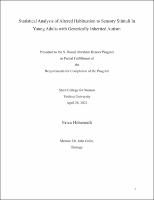Please use this identifier to cite or link to this item:
https://hdl.handle.net/20.500.12202/8252| Title: | Statistical Analysis of Altered Habituation to Sensory Stimuli In Young Adults with Genetically Inherited Autism |
| Authors: | Golin, John Hilsenrath, Erica |
| Keywords: | Altered Habituation to Sensory Stimuli Genetically Inherited Autism |
| Issue Date: | 28-Apr-2022 |
| Publisher: | Yeshiva University |
| Citation: | Hilsenrath, E. (2022, April 28). Statistical Analysis of Altered Habituation to Sensory Stimuli In Young Adults with Genetically Inherited Autism. Undergraduate honors thesis, Yeshiva University. |
| Series/Report no.: | S. Daniel Abraham Honors Student Theses;April 28, 2022 |
| Abstract: | The goal of this study was to determine whether individuals with ASD habituate differently to sensory stimuli when compared to TD participants. Based on the neuronal data for the first 60, there was some evidence to say that our hypothesis was correct, however, this was not the case across all the trials. Even when analyzing the first sixty trials, the significance was minimal. Using this neuronal data and the cognitive test scores a correlation matrix was utilized to determine whether there is a correlation between the cognitive test scores and EEG results. For the ASD experimental group, there is one correlation between neuronal and cognitive scores that had a p-score that was less than 0.05 and that is the correlation between the vineland and the maximum voltage of the P2 peak (Figure 9). It is evident by the negative r value, indicated by the dark blue color in that area, that there is an inverse relationship between the two scores, meaning the higher the vineland score the lower the voltage of the p2 peak. This makes sense since a higher vineland score indicates an individual who is more independent, and the lower voltage indicates habituation. Although this data point did not pass all statistical tests, there is a trend indicating that individuals with ASD who are able to achieve greater levels of independence habituate to sensory stimuli more effectively than those with lower levels of self-sufficiency. There may be many contributing factors as to why the significance level found in terms of difference in habituation was so slight. One possibility is that the stimuli presented to the participating individuals were distinct and often unpredictable. The isochronous condition was 32 the only condition analyzed, however, since the isochronous condition was one of six conditions presented, this may have interfered with the participants brain response to the highly predictable stimulus. If only predictable stimuli were presented to participants, the results may have been more pronounced. Moreover, the isochronous condition was not always presented in the beginning of the trial blocks, so the resulting data may not be as clean as it should be, as the participants' responses may be skewed from previously observed conditions. Lastly, this analysis is only based on sixty trials. For more significant results, we would modify the entrainment to have a more predictable stimulus and many more trials. (from Discussion) |
| Description: | Undergraduate honors program / Open Access |
| URI: | https://hdl.handle.net/20.500.12202/8252 |
| Appears in Collections: | S. Daniel Abraham Honors Student Theses |
Files in This Item:
| File | Description | Size | Format | |
|---|---|---|---|---|
| Erica Hilsenrath OA THESIS Autism 28Apr2022.pdf | 935.16 kB | Adobe PDF |  View/Open |
This item is licensed under a Creative Commons License

